21 February 2025
![]() 18 mins Read
18 mins Read
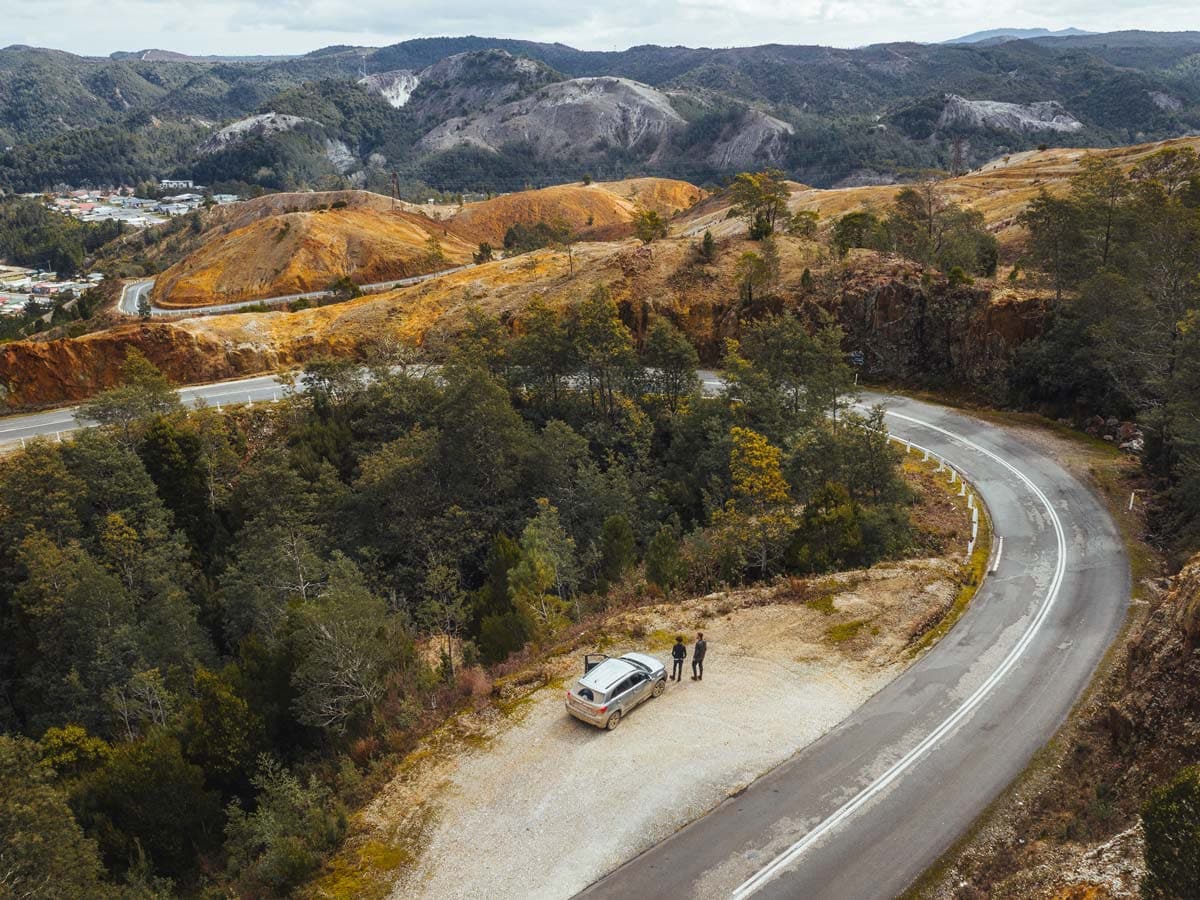
Travellers to Tasmania often overlook the state’s east coast in favour of Hobart and Cradle Mountain, but this is where you’ll find the best of what Tasmania offers.
Drive the east coast and you’ll pass through four national parks, one of Australia’s oldest wine regions (visit Devil’s Corner’s reinvigorated cellar door) and fishing ports where seafood comes straight from the trawlers, or off oyster leases.
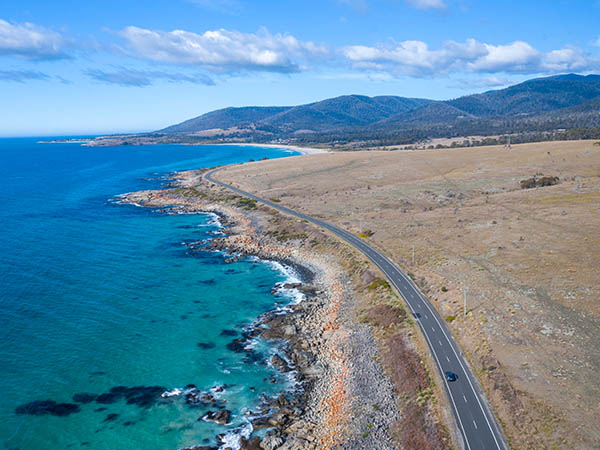
The stunning yet oft-overlooked East Coast of Tasmania is interspersed by white-sand beaches and plenty of foodie hotspots serving up fresh seafood. (Credit: Tourism Australia)
Little penguins swim off the rocks at seaside communities like Bicheno and if it’s beaches you’ve come for, you’ll find two of the world’s best (Bay Of Fires and Wineglass Bay). Though they’re all like that here: there are 200-plus kilometres of white-sand beaches fringed by granite blocks coloured by bright orange lichen.
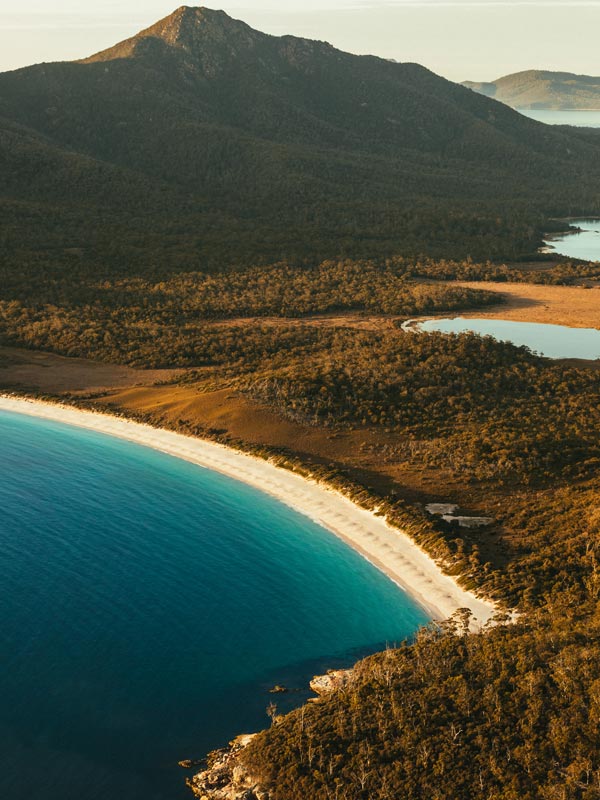
Get your insta pics at Wineglass Bay. (Image: Melissa Findley)
220 kilometres
Words by Craig Tansley
Synonymous with Tasmania’s great outdoors, Cradle Mountain – Lake St Clair National Park is on many nature lovers’ lists. It’s on mine and my eldest son’s as we depart Hobart, hiking boots packed, the GPS set for Sheffield.
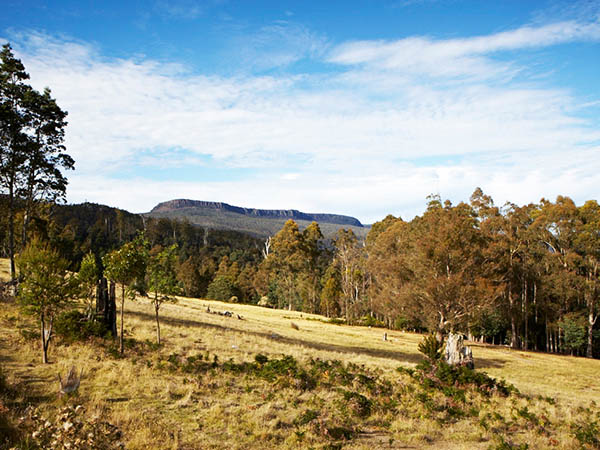
Cruise through the rolling hills and tranquil pastures of Tasmania’s Central Highlands. (Image: Tourism Tasmania/Adrian Cook)
We take the slow and scenic route through the Central Highlands and arrive at the gateway town, which doubles as an outdoor gallery with over 140 murals.
The impressive craggy face of Mt Roland is our silent neighbour as we explore the region and make day trips to Cradle Mountain, an easy 45 minutes’ drive away.
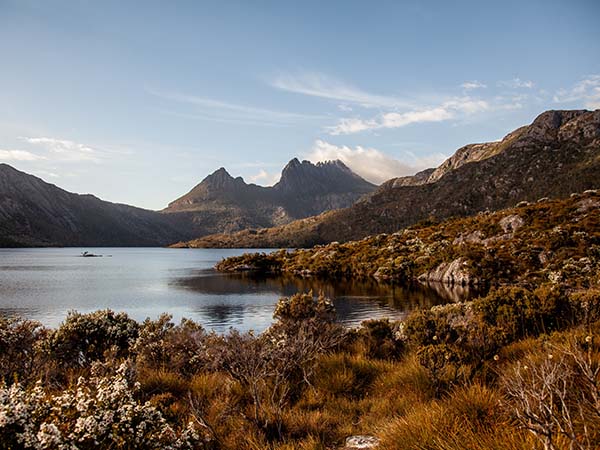
Witness the view of Cradle Mountain, surrounded by the serene waters of Dove Lake. (Image: Cultivate Productions)
321 kilometres
On the slopes of Mt Roland near Sheffield, Silver Ridge Retreat has nine self-contained cottages surrounded by wilderness.
Words by Jennifer Johnston
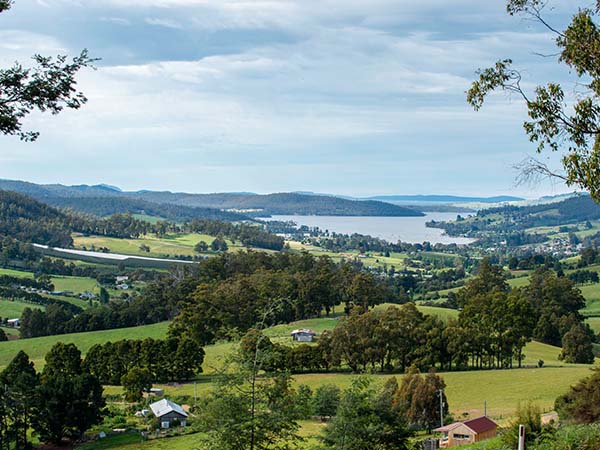
Take in the picturesque countryside around the Huon Valley (Image: @HuonValleyCouncil)
In a land as vast as Australia, road trips often mean long hauls and great distances, but in the Huon Valley, they’re a different beast altogether.
Stretching from just below Hobart to the southernmost tip of Australia, the Huon Valley – or simply the Huon – incorporates a multitude of enchanting landscapes: waterways and wilderness, farms and forests, misty mountains and a charming river that runs through the middle.
Within minutes of leaving the state’s capital, we’re in the countryside, as the cow-dotted hills and scattering of honesty boxes for fresh produce attest. The stretches of orchards that line the road remind us how this Apple Isle earned its name, a precursor to what will become a constant theme on this trip: good food and its connections to the land on which it grows, with a serving of history, adventure and the great outdoors thrown in for good measure.

Acquaint yourself with the quaint countryside of the Huon Valley. (Image: Paul County)
The journey starts at organic Glen Huon Dairy Co., the latest venture for Bruny Island Cheese Co. and the fulfilment of a dream for artisanal cheesemaker Nick Haddow to secure his own supply of sustainable, quality milk.
We meet the stars of the show, all 55 of them, in a combination of specially chosen dairy breeds including the adorably speckled Normandes, also renowned for beef. They’re surprisingly friendly and some hanker for a scratch.
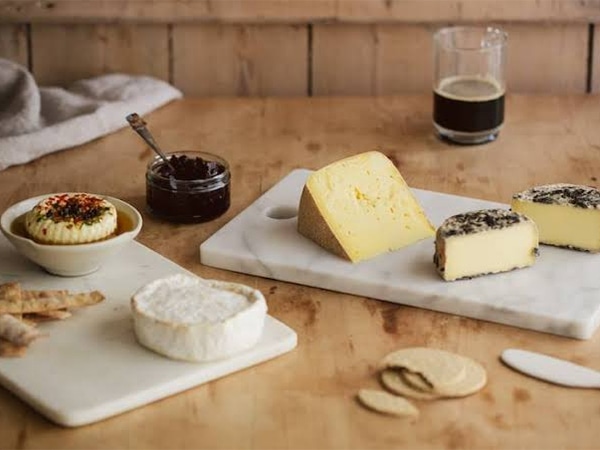
Be prepared to sample at the Glen Huon Dairy Co.
With fresh milk in our tummies and a pinot-washed vine wrapped cheese in hand, it’s not long before we’re getting acquainted with some of the apples we keep driving by, in the form of cider at Frank’s Ciderhouse & Cafe in Franklin.
As the on-site museum records, apple history here runs deep, with the oldest heritage orchards in Australia and the business now in the hands of fifth and sixth generation orchardists.
It’s not all apples: local pears, cherries and raspberries are added into the mix for a variety of sparkling cider options, sampled on a paddle, but for all the choice, I favour the traditional apple all on its own.
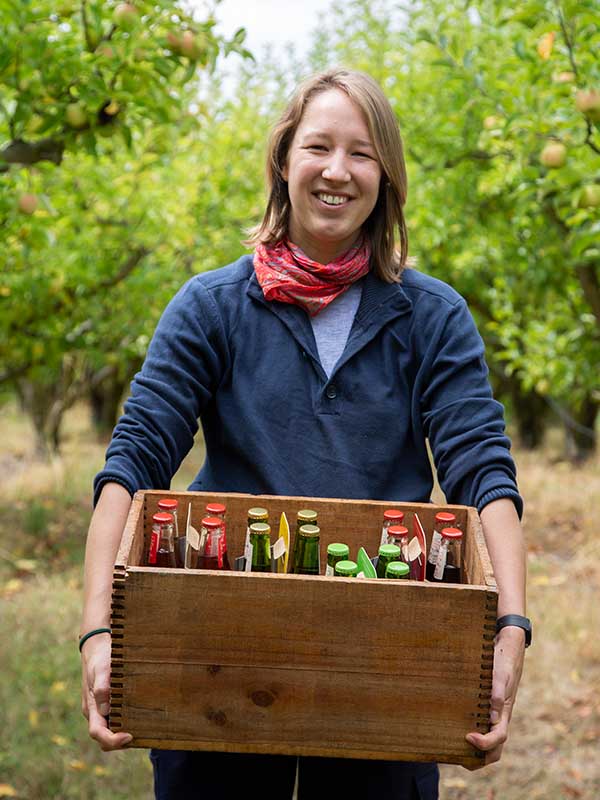
Grab a glass for a refreshing taste of local product at Franks Ciderhouse (Image: Chris Phelps)
The village of Franklin has a long maritime history too, the river once the vehicle for apple cargo. Some of that boating history is being revitalised, thanks to the Wooden Boat Centre, dedicated to maintaining the art of traditional boat building through training and courses, and other locals.
Using their respective skills as rigger and shipwright, Anastasia Konstantinidis and David Golding have for the last seven years been restoring a retired timber fishing ketch, Kerrawyn, to bring her back into service, or ‘into survey’ if we want to get nautical.
Now this locally built 70-year-old workhorse has a more stately purpose: to give an authentic taste of sailing with a leisurely few hours on the scenic Huon while sipping ciders on the celery top pine deck, or longer charters as well.
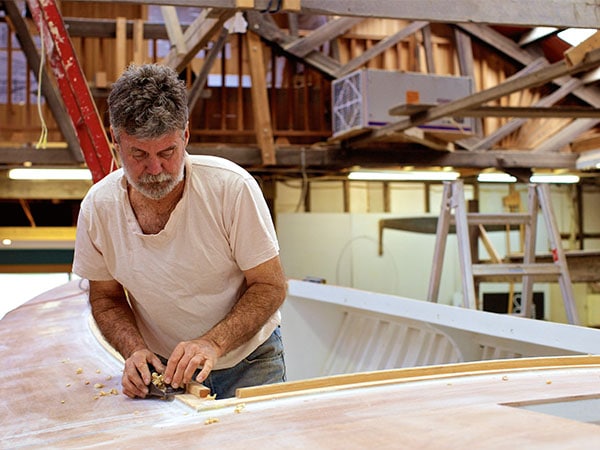
Discover exquisite traditional craftsmanship at The Wooden Boat Centre. (Image: Tourism Tasmania & Adrian Cook
We get even closer to the water on kayaks with a guided tour with Esperance Adventures, gliding through the placid waterways of Port Esperance Bay and French navigational and colonial history.
The vibrant yellow of our crafts dissects the blues of waterways and the distant Hartz Mountains as we pass the islands of Faith, Hope and Charity, the middle one once acting as a probation island for convicts trialling freedom and producing food for the area.
We gather shells that speak of the abundant supply of sea treasures – oysters, abalone, scallops and more – favoured by the local Palawa peoples long before colonials arrived.
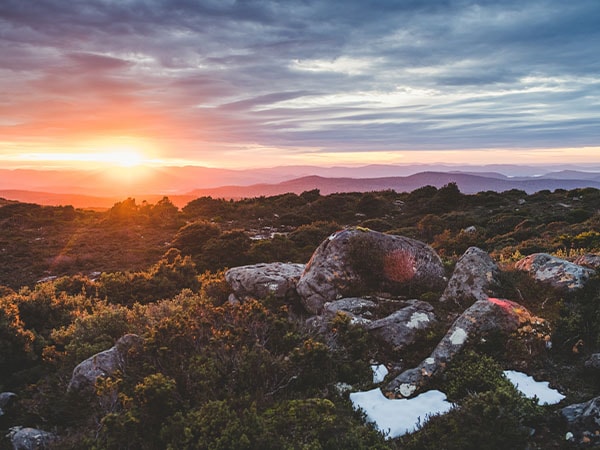
The beautiful Hartz Mountains are on the Southern end of the Huon valley, providing a dramatic backdrop to the region. (Image: Stu Gibson)
Digs for the evening is the delightful Beaupre Cottage in rural Lymington on a working goat farm, but for guests it’s total relaxation. Here choices must be made: a private beach to wander, goats to meet, kayaking or cycling to be done, and walks to take with resident Border Collie, Beau. It’s a real treat.
As far south as the road will take us lies Recherche Bay, a place of tranquillity with a scattering of ‘shacks’ at Cockle Creek and an abundance of secluded white beaches, shore birds and wildlife. We opt for the stunning two-hour coast-hugging, rock-clambering walk to Fishers Point (best taken at low tide) with views for days, and breathe in the calm.
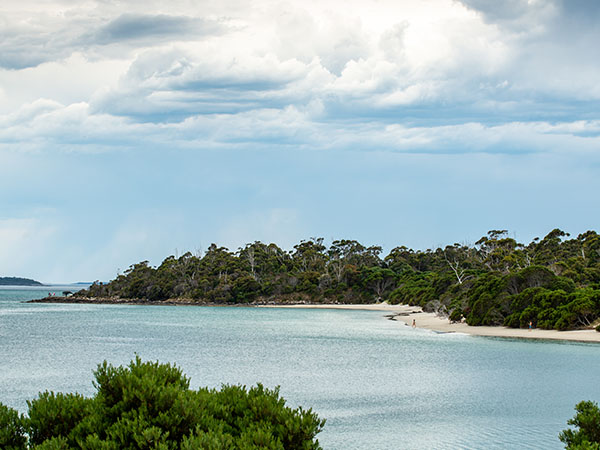
Take in a serene ocean view at Cockle Creek, Australia’s southernmost drivable location. (Image: @huonvalleycouncil)
The reputation of Tasmania’s south-west as a region of remarkable beauty notwithstanding, I’m unlikely to venture too deeply into its spectacular wilds, but Tahune Adventures right at its edge near Geeveston provides a perfect alternative.
It’s there we take the 600-metre airwalk through the forest canopy, 50 metres above the Huon River with glimpses into the mountains of the Tasmanian Wilderness World Heritage area beyond, walk along the suspension bridges and wander the fern-filled walk at ground level.
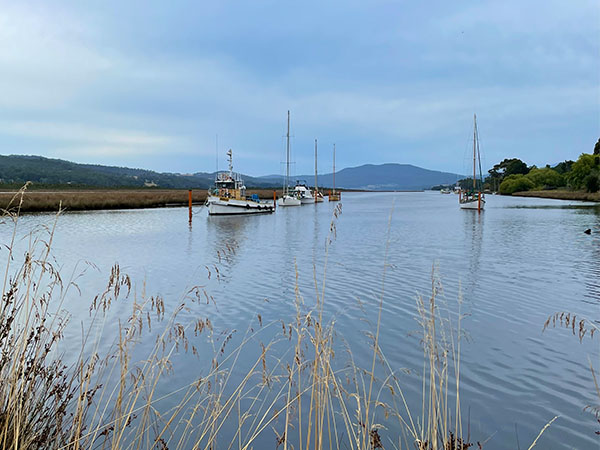
Relax at the Huon river, surrounded by luscious forests. (Image: Christine Aldred)
Fully accessible to wheelchairs, prams and even dogs on leads, it’s a forest experience anyone can take part in and witness some of the region’s recovery after devastating bushfires in 2019. For those yearning for an adrenaline kick, the ‘eagle’ zipline provides another view.
We’ve put down an impressive daily step count so it’s fortunate a special treat awaits at Fair Winds, our luxury home for the evening at Brooks Bay with stunning vistas and an outdoor tub from which to soak it in.
As if that’s not enough, we up the ante with our own private chef: ex-MasterChef contestant Sarah Clare is now sharing her skilful delight in food through Essentially Tas, which provides accommodation options with home dining add-ons.
The evening’s fare is local, seasonal produce, driven by Sarah’s belief we should know where our food comes from: ‘I don’t want my food to have travelled further than I have.’
Her love of foraging is evident: there are three types of fish she caught the day before, leeks from her garden, lemons from her dad’s and samphire from the sea, and that’s just for starters, with local wines of course. It’s an exceptional evening all round.
Wherever we go, the themes of local produce and food communities abound. At nearby Geeveston, a quaint timber town, we lunch at Harvest and Light, a small-batch picklery with a photographic gallery on the side, where Sarah also works.
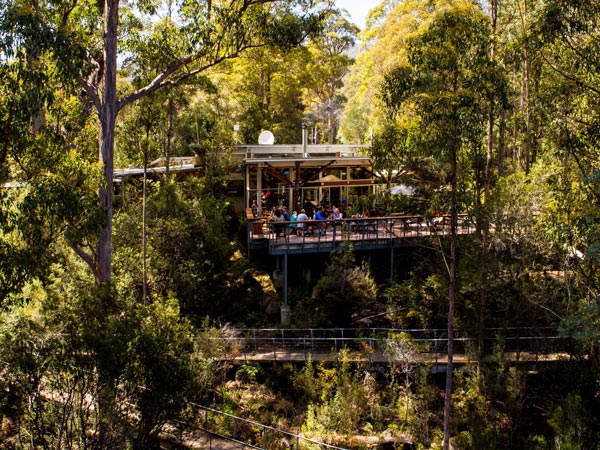
Geeveston is a character-filled country town in the Huon Valley. (Image: Tahune Adventures Geeveston)
There, pickler and photographer Cassy Faux preserves myriad fruit and veg and offers pretty-as-a picture tasting plates with a selection of cheeses, along with local beverages.
The ‘honour wall’ next to the kitchen is a shout-out to the host of locals who’ve donated produce to be converted into pickles, preserves and even fruit syrups. This week it’s grapefruits, sometimes zucchinis or lemons, but whatever it is, Cassy is always grateful as it echoes her overriding business ethos of minimising waste and connects her to the local community.
In the Italian way, Martino Crippa and Sofia Panfili, of Osteria at Petty Sessions, in Franklin’s old courthouse, make most of the food they serve from scratch: prosciutto and coppa, preserved fish, ricotta, their ‘kick-ass tiramisu’ and, of course, pasta.
While their Umbrian heritage features strongly at their restaurant, they also incorporate a lot of local produce, grown by neighbours and friends, like the apples and blueberries in the dessert terrine with ice-cream. Don’t miss the light as-a-feather gnocchi.
Port Cygnet CanneryAt Port Cygnet Cannery, once the hub of Cygnet’s economy as an apple cannery factory, it’s no longer just about the pizzas created in ‘Dante’, the Italian pizza oven that takes pride of place in the middle of the restaurant.
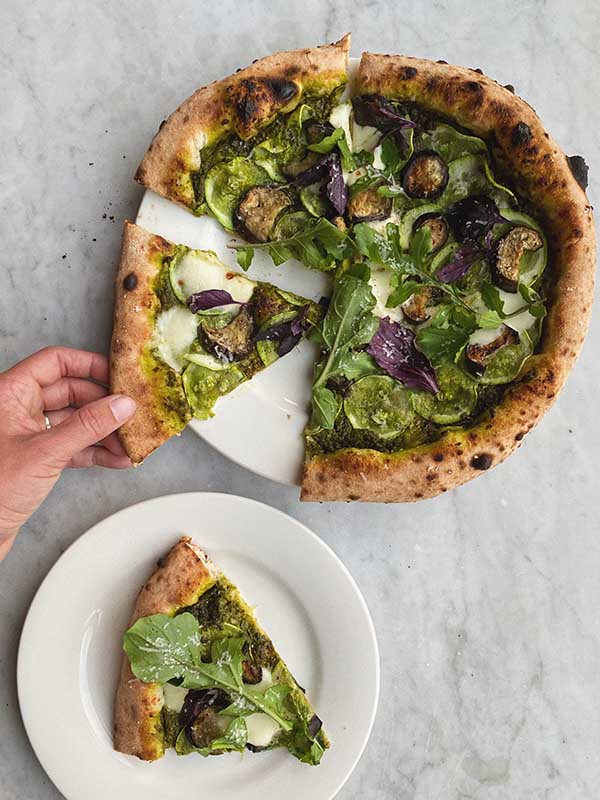
Indulge in a slice at the iconic Port Cygnet Cannery.
After its recent ritzy makeover, the weekend feasts of garden goodness – fresh from nearby Gardners Bay Farm, its sister enterprise – are now pulling the crowds, too.
We’ve toured the farm with the gardener, learnt about soil biology, felt the compost and plucked purple beans from the vines, so we feel connected to our meal and the people who grew it.
In fact, it’s all very connected. The Huon Valley offers a dozen road trips in one compact space and it’s up to you to choose your own flavour. Whichever road you travel, another adventure awaits: cool-climate wineries, cideries on tap, thermal springs and ancient crystal caves for starters. And with scenery like this, who cares if there’s a little backtracking here or there?
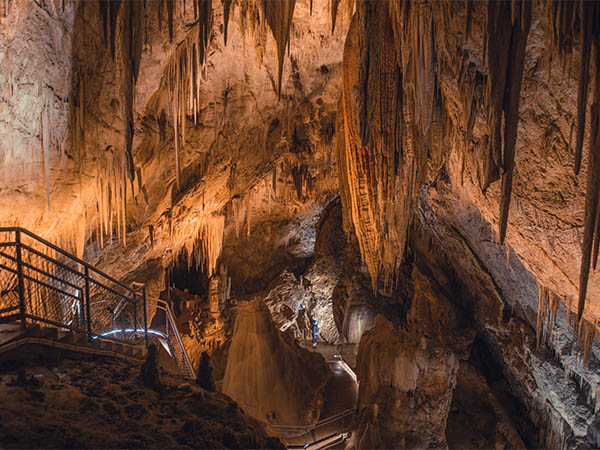
Explore Tasmania’s otherworldly crystal caves. (Image: Jess Bonde)
Southwest National Park offers limited free camping at Cockle Creek (parks pass required) on a first-come first-served basis. BYO fresh water and supplies. To extend your forest exploration, Tahune Adventures offers caravan and campervan sites for $10 a night with purchase of entry ticket or simple two-bedroom cabins.
Frida – a teal 1975 VW Kombi – provides charming creek-side accommodation with boho or retro vibes in a private patch of country bliss in Upper Woodstock. Fully off-grid, Kombi Kamp includes a kitchen hut with pot-belly stove, fire pit for roasting marshmallows, fairy lights and homemade treats. Bathe in the bubbling creek or shower under the stars, and bask in the serenity.

Recharge in Retro style in Frida, the teal 1975 Kombi with lots of character.
Villa Talia is set on four hectares a five-minute drive south of Franklin. This luxury three-bedroom villa offers an indulgent outdoor lounge and dining space, an infinity lap pool, private yoga lessons by request and garden, river and mountain views all at once.
Words by Christine Aldred
Flanked by gently rumpled farmland where sheep huddle together for warmth, the Midland Highway linking Launceston and Hobart is hardly Tasmania’s most scenic drive and the 16 roadside silhouettes of stagecoaches, surveyors and soldiers that line the route provide a welcome distraction.
But a key element was missing from these colonial scenes until this year. Commissioned by Mona Foma festival, Trawlwoolway artist Julie Gough’s additions, The Missing, depict all-too-common acts of state-sanctioned violence in the colony’s early days, but they also look further back.
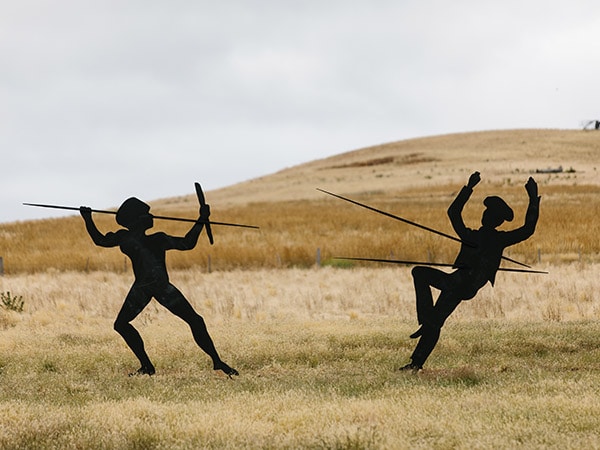
‘The Missing’ is a powerful artwork that confronts Australia’s history of colonial violence. (Image: MONA/Jesse Hunniford)
On a hillside surrounded by knee-high grass, a lone figure with a fire stick represents 10,000 years of traditional land management practices. From another angle on the return journey, it serves as a literal torchbearer for future generations.
200 kilometres
When you arrive in Hobart, get a closer look at some iconic local artworks with a stay at Mona Pavilions.
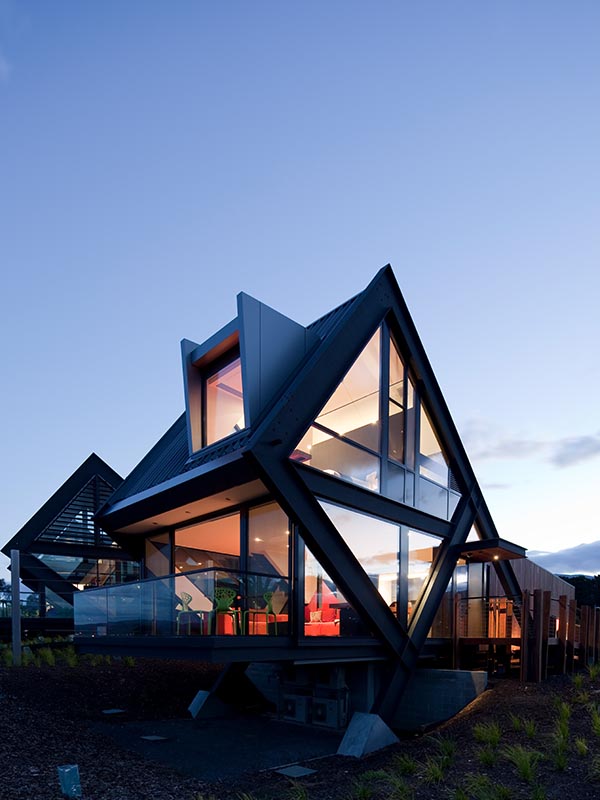
Relax in style at Mona Pavillions, contemporary accommodation just a short distance from Hobart. (Image: Brett Boardman)
Words by Alexis Buxton-Collins
This place, where fragile rainforest exists alongside mining’s messes, is in the throes of reinvention. Give yourself only a day in Queenstown and you’ll drive away wishing you’d made more time for mountain-biking, a Roam Wild tour, lunch at Linda Cafe, a rainforest hike, dinner at the Empire, a film at the Paragon Theatre or a bed at Penghana B&B.
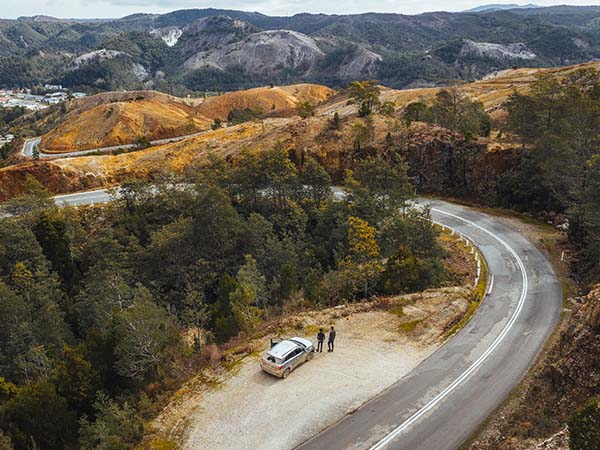
The forests around Queenstown provide ample opportunity for hiking, biking and exploring. (Image: Jason Charles Hill)
From Queenie, head north to Zeehan and bike or hike Spray Tunnel Loop. Further north, you’re nearly at Corinna when you hit that silica road, made from tailings. Stay in a cottage on the banks of the Pieman River near takayna/the Tarkine. The next day, take a small-boat sunrise cruise or hire a kayak.

Set off on the serene waters of The Pieman to catch an early morning sunrise. (Image: Places We Go)
Queenstown to Corinna via Zeehan is 86 kilometres.
Words by Elspeth Callender
This isn’t a road trip. It’s looking through a viewfinder; scenes that change by the hour as we lasso Tasmania’s north-eastern heart – snow-fringed lakes to rainforest, dairy pastures to lichen-coated granite, golden plains and towering peaks.
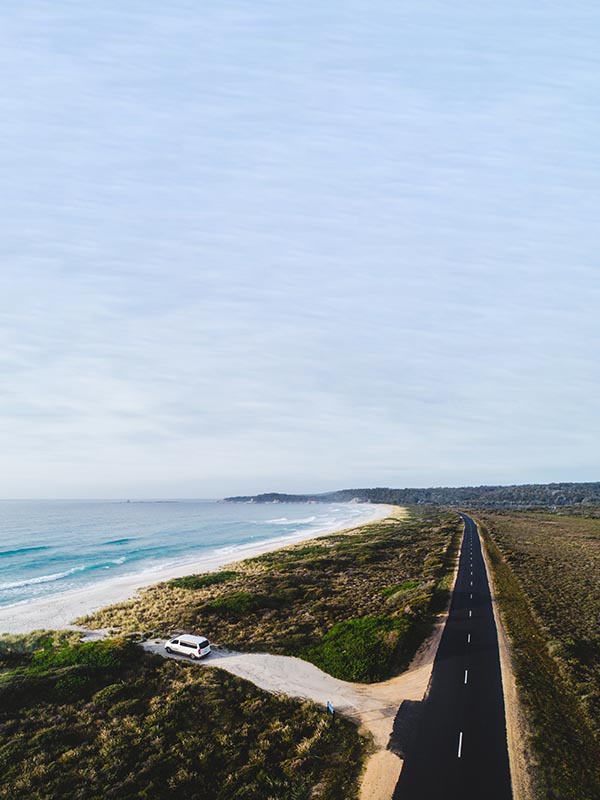
Witness the magnificence of Tasmania on a tour through its oft-overlooked north-eastern corner. (Image: Stu Gibson)
Like any adventure, the best road trips are those that happen when you take an unexpected turn. Mislaid plans to explore Cradle Mountain with a toddler during a cold snap have led us north, skirting yingina/The Great Lake where quintessential Tassie shacks hide between the trees.
It leads us, and our campervan, to Deloraine – 40 minutes shy of Launceston – where our campsite offers up platypus spotting and the worthy kooparoona niara Cultural Trail on the banks of the Meander River.
While our ultimate destination is Falmouth on the east coast, what we do between here and there is open to chance. It means we end up balancing wine tasting in the West Tamar Valley with an indoor play centre in Launceston on a rainy day. We free camp amid mountain-biking families in Derby and I plunge into its frosty depths after stints in the Floating Sauna.
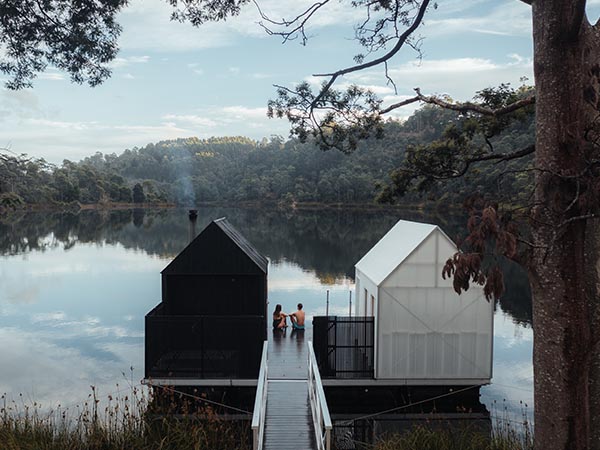
Unwind in a floating sauna– a little taste of Scandinavia set in the stunning surrounds of Tasmania. (Image: Jason Charles Hill)
We hike to St Columba falls and go cow-spotting at Pyengana Dairy and, as we emerge in St Helens, greens make way for piercing turquoise seas lapping scarlet rocks and we camp in the dunes for next to nix.
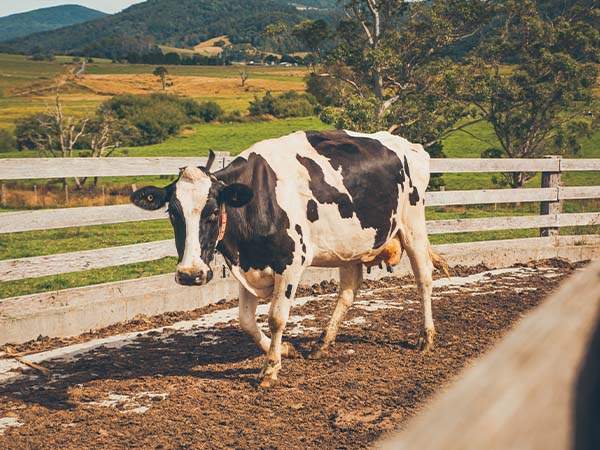
Discover the art of cheesemaking at Pyengana Dairy Company (Image: Flow Mountain Bike)
En route to Launceston, the scenery – past Ben Lomond National Park, through small towns like Fingal, Conara and Carrick – only proves how cinematic Tassie really is.
532 kilometres
Words by Celeste Mitchell
Tasmania’s north-west coastline provides one of Australia’s most blissfully lonely drives. Head north-west from Launceston taking in some of the Cradle to Coast Tasting Trail (you’ll traverse some of Tasmania’s most productive farmland) till you reach tiny towns with names like Penguin built right on the water’s edge.
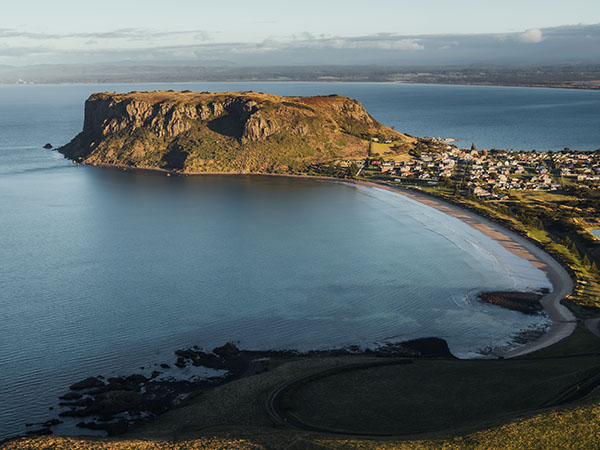
Trace the craggy Tassie coast and take in the remarkable views. (Image: Charles Hill)
There’s more tractors than cars out here; stop in Stanley for a night at the 173-year-old Ship Inn, then head out to the west coast and follow the cliffs where Australia’s biggest waves break till the road turns gravel as you loop your way through takayna/Tarkine, the second largest tract of cool temperate rainforest left on Earth.
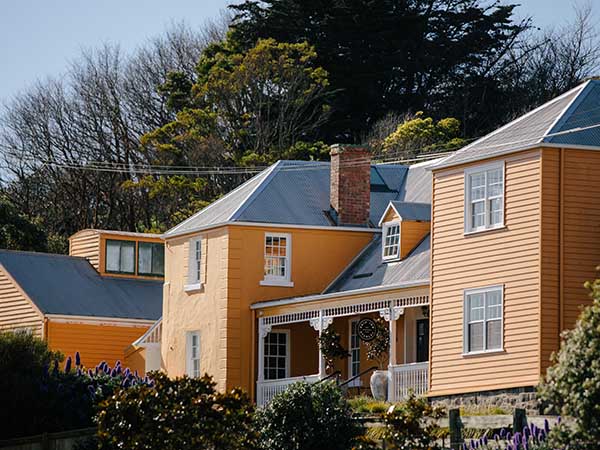
A stay at the historic Ship Inn is a fantastic way to experience the rustic vibes of rural Tassie. (Image: Lusy Productions)
600 kilometres (loop from Launceston)
Words by Craig Tansley
Though you may need to nominate someone else as the designated driver for this journey, those with a passion for handcrafted tipples can make this the driving force behind a trip around Tassie. The Tasmanian Whisky & Spirits Trail links the island state’s artisan distillers, from trailblazer Lark Distillery in Hobart to Australia’s southernmost whisky distillery McHenry on the Tasman Peninsula, to Southern Wild, Tasmania’s newest gin distillery, on the wild north coast.
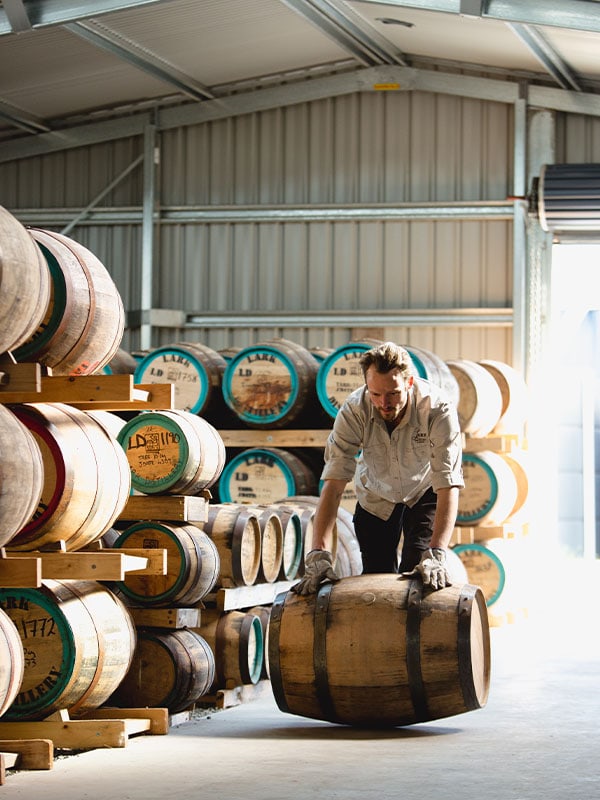
Those with a passion for handcrafted tipples should make their way to Tassie. (Image: Destination NSW)
380 kilometres north to south.
Spend the night in the Devil’s Lair Cabin on site at McHenry Distillery for a whisky nightcap washed down with a side of dark sky stargazing from an observatory inside a converted barley silo.
On the edge of the escarpment a road sign warns of wiggles for seven kilometres. I grin under my helmet for the hundredth time since leaving historic Bothwell. Though, if that storm catches up to my BMW F 750 GS, it’ll be no joke. Lakes Highway is a scenic south-north route that weaves, at altitude, between countless lakes and shack-heavy fishing settlements. Raindrops speck my visor as I wind my way down from kooparoona niara – the original palawa name for Great Western Tiers – and hairpin through deep-green forest. Meander Valley is in sunshine. Lambs scatter and calves stare as I ride the backroads to my accommodation of Wandering Trout Taphouse in Mole Creek.
Bothwell to Mole Creek via Highland Lakes Road/A5 is 150 kilometres.
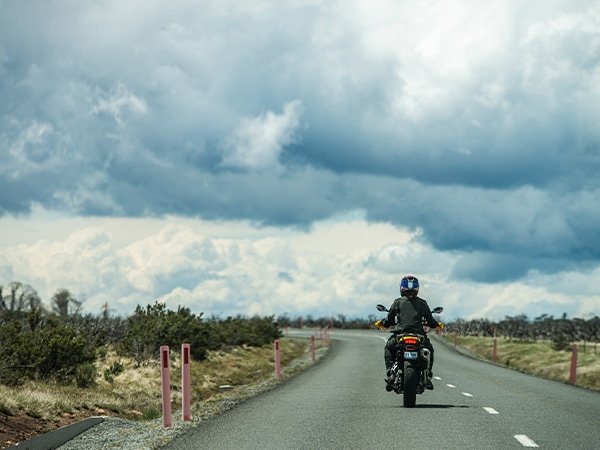
Raindrops speck my visor as I wind my way down from kooparoona niara. (Image: Chris Crerar)
The dark, the cold, the bizarre and the ever-so-slightly bonkers are embraced during the iconic Dark Mofo festival, which takes place during the winter solstice in the Tassie capital of Hobart. The program differs from year to year, but at any given time you are sure to be challenged, confounded and even provoked by the events taking place across the city and out to the spiritual home of the festival, the Museum of New and Old Art (MONA).
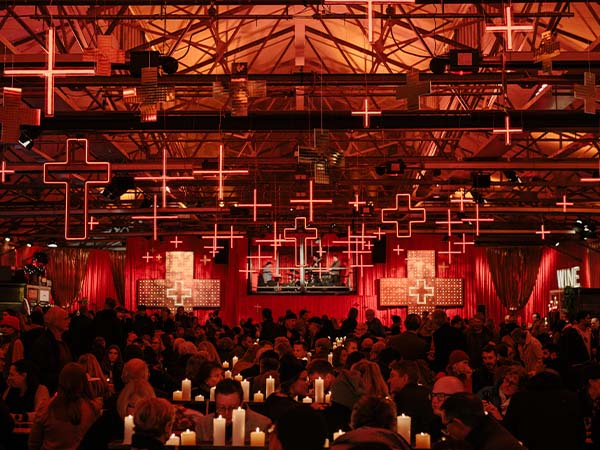
Embrace the darkness at Dark Mofo’s winter feast. (Image: Dark Lab Media)
Let Inspiring Journeys be your designated driver for the duration with its four-day Dark Mofo Long Weekend itinerary, ferrying you to and from Hobart and MONA, and on to New Norfolk for lunch at Agrarian Kitchen Eatery, housed (in true Dark Mofo style) within a former mental asylum.
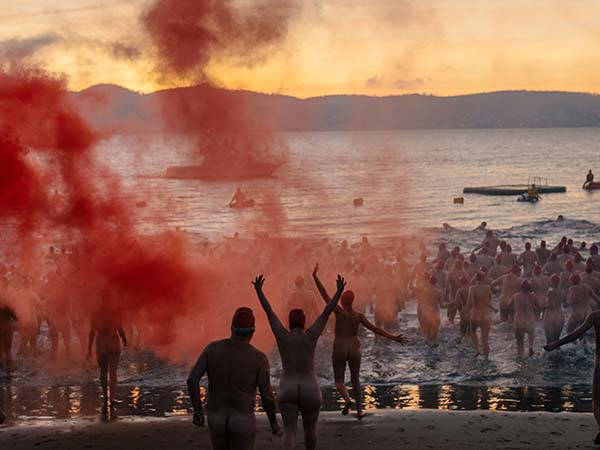
Take an exhilarating swim in the chilly waters of Hobart’s River Derwent for Dark Mofo’s winter solstice nude swim (Image: Dark Lab Media)
For the time-poor who don’t have weeks to get lost on Tassie’s wonderfully winding B-roads, the Tasman Peninsula offers a concentrated, scrumptious bite of Apple-Isle richness. Far from just the ‘way to Port Arthur’, there is plenty to see and do. Nature-wise, sample one of the handful of spectacular short strolls – head for Tasman Arch – or explore the ferocious coast from the sea-side on a Tasman Island Cruise from Port Arthur.
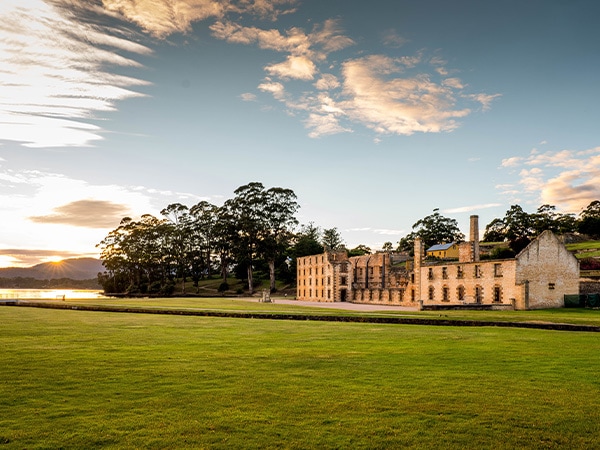
Take a step back in time at the historic Port Arthur. (Image: Alastair Bett)
Get a refined sugar-high at Tasmanian Chocolate Foundry, Taranna, sate the kids’ critter urges at nearby Tasmanian Devil Unzoo, then regain your centre at Port Arthur Lavender Farm. Loop towards Nubeena to drive your own ‘dirt-road distillery’ adventure (tick off McHenry, Impression Bay and Hellfire Bluff distilleries). Late lunch on homemade lamb meatballs and homegrown cool-climate pinot noir at Bangor Vineyard Shed (book ahead).
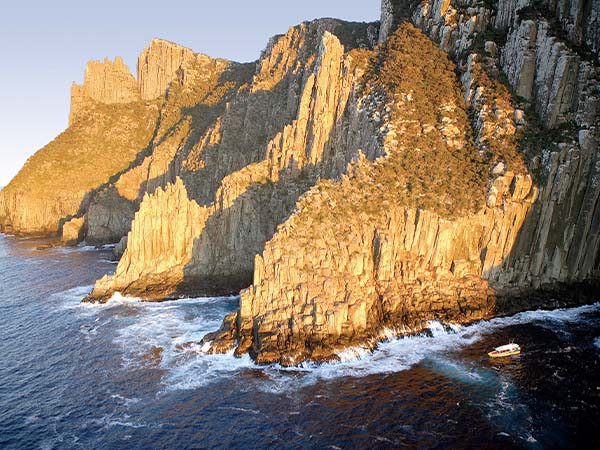
Set off on the sea and view the jagged coastline around Port Arthur. (Image: Tourism Tasmania & Joe Shemesh)
210 kilometres (Hobart to Port Arthur return).
Words by Steve Madgwick
LEAVE YOUR COMMENT